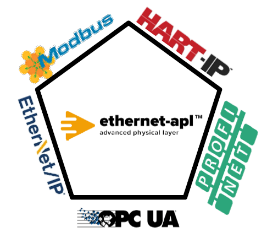
HOW & WHY to going to HART-IP technical applications
Future APL Vision: Lower Cost Infrastructure
Overview
The four leading industrial protocol organizations that previously had different fieldbus technologies came together to create a common 2-wire intrinsically safe advanced physical layer (APL): Ethernet-APL, which supporting multiple application protocols.
APL supports the IP protocols from all four organizations: HART-IP, PROFINET, OPC-UA, EtherNet/IP, and many more. Each protocol has its strengths, with a sweet spot certain kind of devices. User’s wish for a single network supporting all kinds of devices using a mix of protocols is now a reality. Each device using the protocol most suited for the function it performs. Information and Communications Technology(ICT) protocols like FTP, HTTP, and SMTP are also supported by APL.

■ Future APL Vision: Lower Cost Infrastructure
The vision for the future is a single Ethernet-APL cable infrastructure to support all kinds of field devices. Ethernet-APL instruments will not be lower cost than 4-20 mA instruments, but a single infrastructure will lower cost than multiple infrastructures, In the interim there will be a mix of APL, 4-20 mA, and on-off signal devices.
4-20 mA/HART devices can be fitted with an Ethernet-APL adapter using the HART-IP protocol. APL is high-speed, 10Mbit/s, sufficient for high-bandwidth use-cases like streaming process video on the same network as field instruments like transmitters and valves. With APL junction boxes in place, you will be able to easily connect another transmitter or a process video camera without laying new infrastructure. The APL field switch provides intrinsically safe power over the same 2-wires so additional power cable is not required for most devices.
■ Challenges with Traditional Field Device Integration
Today process units have multiple heterogenous wiring infrastructures which is complex and costly, particularly with flameproof/explosion proof explosion protection. Adding devices is a lot of work. RS485 is slow and each network only carry one protocol, so need many cables to support multiple protocols to integrate all the devices in the plant.
The bus is either Modbus, or Profibus, or DeviceNet, or HART. There are multiple RS485 networks like Modbus/RTU, Profibus-DP, and even proprietary protocols. Analog signals are distorted during transmission and there are D/A and A/D conversation errors. For instance, limited due to high resistance, biased due to ground loop, non-linear safety barriers etc., conversion quantization error, and calibration differences.
Analog errors go undetected: on-scale failures. Each signal requires a pair of wires: Every measurement signal and valve setpoint. On-off and pulse signals do not come with the ability to access intelligence in devices. Users demanded a solution where all kinds of devices using different protocols can share the same network.
■ Converged IP-Everywhere: Single Shared Infrastructure
A key success factor for the internet protocol (IP), Ethernet, Wi-Fi, and the Internet, is that they were all designed to carry multiple application protocols. And no single application protocol attempts to perform all functions. There is a specialized protocol for each function. At home and in the office, FTP is used for file transfer, HTTP for web browsing, and SMTP for mail. Office software makes the protocol transparent; most don’t even know notice
protocol is used. Similarly, in a plant HART-IP is used for all instrumentation, Modbus/TCP for all other things. Similarly, automation systems make the protocol transparent, most don’t even notice which protocol is used which makes it easy to use. But remember, Ethernet and IP don’t necessarily mean ‘open’and interoperable, many devices use proprietary application protocols.
There is TCP transport protocol mostly for client-server type communication relationships and there is UDP transport protocol mostly for publisher-subscriber communication relationships. A vast selection of physical media exists, both wired and wireless solves a many use-cases. Most importantly, they all use IP as the network protocol including IP address: the hourglass shape.
■ Multi-Port Repeater: Signal Robustness
APL can use the same cable as fieldbus, with some exceptions. But APL is not a fieldbus. Fieldbuses are digital too and do have all the benefits of digital signals. However, a connection fieldbus ‘hub’ with repeater on each spur never came to market. A passive connection block does not prevent noise propagation. Some users experienced challenges with noise. An APL field switch at its core is an Ethernet switch so it has a repeater on each spur which helps prevent noise propagation to the trunk and other spurs. This makes APL more resilient and easier to troubleshoot. For more further discussions and exchanges are welcome.
For more further discussions and exchanges are welcome.
This email address is being protected from spambots. You need JavaScript enabled to view it.
https://www.chinasimba.com
